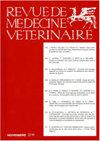Frecuencia y caracterización de las principales neoplasias presentes en el perro doméstico en Tamaulipas (México)
Q2 Veterinary
引用次数: 3
Abstract
In Mexico, research on veterinary oncology is scarce. This is the first report on the most common neoplasms in domestic dogs in northeastern Mexico, which establishes important bases for future epidemiological research. A retrospective study covering 2013 and a prospective study from January to August of 2014 was carried out in the Animal Pathology Department of the Faculty of Veterinary Medicine and Animal Science at the Universidad Autonoma de Tamaulipas, as well as in a private laboratory. A total of 250 samples of cytopathology and histopathology of tumors or lesions suggestive of neoplasms were analyzed. 213 of them were diagnosed as neoplasms and 37 as non-neoplastic processes. Malignant neoplasms were more frequent than benign ones. They were classified as epithelial or mesenchymal neoplasms. Mixed breed dogs were the most affected, followed by the Labrador breed. Female dogs developed tumors with the highest frequency, with 145 records. For the statistical analysis, Fisher’s exact test was used, which determined the existence of a statistically significant association (p < 0.05) between the presence of the five most frequent types of tumors and the patients’ sex, race, and age in the development of neoplasms. No significant differences were observed when evaluating the relation of the neoplastic tumor with race and sex, although there was a significant difference (p < 0.05) regarding the patients’ age.塔毛利帕斯州(墨西哥)家犬主要肿瘤的频率和特征
在墨西哥,对兽医肿瘤学的研究很少。本文首次报道了墨西哥东北部家犬最常见的肿瘤,为今后的流行病学研究奠定了重要基础。在塔毛利帕斯州自治大学兽医和动物科学学院动物病理学系以及一个私人实验室进行了2013年的回顾性研究和2014年1月至8月的前瞻性研究。对250例肿瘤或提示肿瘤病变的细胞病理学和组织病理学标本进行了分析。其中213例诊断为肿瘤,37例诊断为非肿瘤。恶性肿瘤多于良性肿瘤。它们被分类为上皮性或间充质肿瘤。混合品种的狗受影响最大,其次是拉布拉多品种。雌性狗患肿瘤的频率最高,有145例记录。统计分析采用Fisher精确检验,该检验确定五种最常见肿瘤类型的存在与患者的性别、种族和年龄在肿瘤发展过程中存在统计学上显著的关联(p < 0.05)。在评价肿瘤与种族、性别的关系时,差异无统计学意义,但在评价患者年龄时,差异有统计学意义(p < 0.05)。
本文章由计算机程序翻译,如有差异,请以英文原文为准。
求助全文
约1分钟内获得全文
求助全文
来源期刊

Revue De Medecine Veterinaire
农林科学-兽医学
CiteScore
1.30
自引率
0.00%
发文量
0
审稿时长
18-36 weeks
期刊介绍:
The Revue de Médecine Vétérinaire publishes four kinds of text:
1) Scientific reviews on subjects related to veterinary and comparative medicine. Suggested length: 10 to 30 typed pages.
2) Original reports on fundamental or applied research. Suggested length: 10 to 15 typed pages.
3) Continuous education articles, that should be easily understandable by non-specialists. Suggested length: 10 to 15 typed pages.
4) Clinical reports. Suggested length: 5 to 15 typed pages.
The publication can be done in French language or English language.
For an article written in English by not english native speakers authors, the manuscript must be subjected by attesting that it was read again by an anglophone scientist or a scientific translator.
The authors must certify that the manuscript was not published or subjected for publication to another review.
The manuscript must be accompanied by a sheet signed by all the joint authors indicating their agreement for the tender of the manuscript.
The publication is free but a financial participation could be required for the photographs color. An estimate will be sent to collect the agreement of the authors.
 求助内容:
求助内容: 应助结果提醒方式:
应助结果提醒方式:


